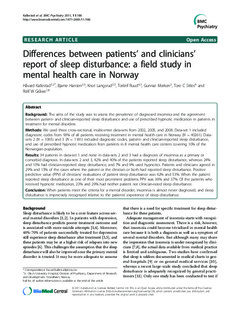| dc.contributor.author | Kallestad, Håvard | |
| dc.contributor.author | Hansen, Bjarne | |
| dc.contributor.author | Langsrud, Knut | |
| dc.contributor.author | Ruud, Torleif | |
| dc.contributor.author | Morken, Gunnar | |
| dc.contributor.author | Stiles, Tore C | |
| dc.contributor.author | Gråwe, Rolf W. | |
| dc.date.accessioned | 2018-01-03T10:11:57Z | |
| dc.date.available | 2018-01-03T10:11:57Z | |
| dc.date.created | 2012-01-08T19:23:49Z | |
| dc.date.issued | 2011 | |
| dc.identifier.issn | 1471-244X | |
| dc.identifier.uri | http://hdl.handle.net/11250/2474293 | |
| dc.description.abstract | Background
The aims of the study was to assess the prevalence of diagnosed insomnia and the agreement between patient- and clinician-reported sleep disturbance and use of prescribed hypnotic medication in patients in treatment for mental disorders.
Methods
We used three cross-sectional, multicenter data-sets from 2002, 2005, and 2008. Data-set 1 included diagnostic codes from 93% of all patients receiving treatment in mental health care in Norway (N = 40261). Data-sets 2 (N = 1065) and 3 (N = 1181) included diagnostic codes, patient- and clinician-reported sleep disturbance, and use of prescribed hypnotic medication from patients in 8 mental health care centers covering 10% of the Norwegian population.
Results
34 patients in data-set 1 and none in data-sets 2 and 3 had a diagnosis of insomnia as a primary or comorbid diagnosis. In data-sets 2 and 3, 42% and 40% of the patients reported sleep disturbance, whereas 24% and 13% had clinician-reported sleep disturbance, and 7% and 9% used hypnotics. Patients and clinicians agreed in 29% and 15% of the cases where the patient or the clinician or both had reported sleep disturbance. Positive predictive value (PPV) of clinicians' evaluations of patient sleep disturbance was 62% and 53%. When the patient reported sleep disturbance as one of their most prominent problems PPV was 36% and 37%. Of the patients who received hypnotic medication, 23% and 29% had neither patient nor clinician-rated sleep disturbance.
Conclusion
When patients meet the criteria for a mental disorder, insomnia is almost never diagnosed, and sleep disturbance is imprecisely recognized relative to the patients' experience of sleep disturbance. | nb_NO |
| dc.language.iso | eng | nb_NO |
| dc.publisher | BioMed Central | nb_NO |
| dc.rights | Navngivelse 4.0 Internasjonal | * |
| dc.rights.uri | http://creativecommons.org/licenses/by/4.0/deed.no | * |
| dc.title | Differences between patients’ and clinicians’ report of sleep disturbance: a field study in mental health care in Norway | nb_NO |
| dc.type | Journal article | nb_NO |
| dc.type | Peer reviewed | nb_NO |
| dc.description.version | publishedVersion | nb_NO |
| dc.source.volume | 11 | nb_NO |
| dc.source.journal | BMC Psychiatry | nb_NO |
| dc.identifier.doi | 10.1186/1471-244X-11-186 | |
| dc.identifier.cristin | 879306 | |
| dc.description.localcode | © 2011 Kallestad et al; licensee BioMed Central Ltd. This is an Open Access article distributed under the terms of the Creative Commons Attribution License (http://creativecommons.org/licenses/by/2.0), which permits unrestricted use, distribution, and reproduction in any medium, provided the original work is properly cited. | nb_NO |
| cristin.unitcode | 194,65,35,0 | |
| cristin.unitcode | 194,67,40,0 | |
| cristin.unitname | Institutt for psykisk helse | |
| cristin.unitname | Institutt for psykologi | |
| cristin.ispublished | true | |
| cristin.fulltext | original | |
| cristin.qualitycode | 1 | |

